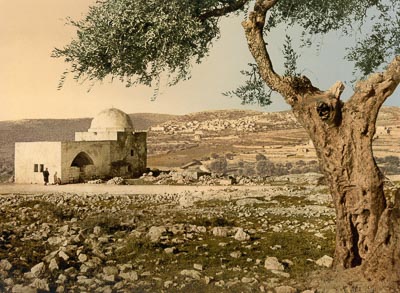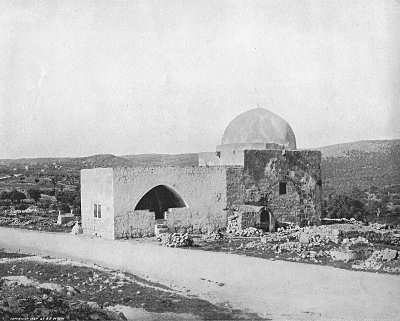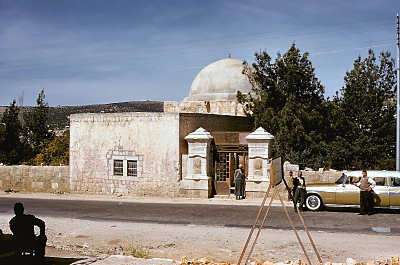
Rachel's Tomb

Source: The Holy Land in Photochrom
Rachel's Tomb
The "Sepulchre of Rachel" is a modern building, a small dome surmounting a square chamber at one end, and nothing particular in form or material in any part of it.. . . There is much of simple pathos in the Bible narrative, which will be read on the spot, or even with a faithful picture before one, with new and fresh interest: "And they journeyed from Beth-el; and there was still some way to come to Ephrath...And Rachel died, and was buried in the way to Ephrath (the same is Beth-lehem). And Jacob set up a pillar upon her grave: the same is the pillar of Rachel's grave unto this day." The pillar was still there when Moses wrote the narrative in the Book of Genesis. It has long since been swept away; but thirty centuries of sorrow and suffering have not been able to sweep away the memory of it from the hearts of Rachel's posterity. The monument is there yet, retaining the name of the patriarch's beloved wife. (Source: Jerusalem, Bethany, and Bethlehem, p. 115.)
Rachel's Tomb

Source: Earthly Footsteps of the Man of Galilee, p. 34.
This is an almost undisputed site. Jews, Moslems and Christians all agree that here Rachel was entombed. The pillar Jacob set up has long since disappeared, but some mark has marked the spot for thirty-six hundred years. The present square structure, surmounted by a central dome, is modern. It measures twenty-three feet on each side. The height of the wall is twenty feet and the dome is ten feet high. The eastern chamber is twenty-three feet long by thirteen feet broad. The inner chambers are used by the Jews, who meet here every Friday to pray, and a few years ago Sir Moses Montifiore repaired this building. (Source: Earthly Footsteps of the Man of Galilee, p. 34.)
Rachel's Tomb
The present tomb, a Saracenic building, subsequent certainly to the Crusading times, is neither rich nor imposing, but no sumptuous mausoleum is needed to keep in memory the grave of Rachel-beautiful, beloved, untimely taken away . . . . It is mentioned by Jerome and in the Crusading chronicles, and was visited by Maundrell two hundred years ago. We may well recall how the prophet represents Rachel sitting weeping for her children as the long train of captive exiles passed from the south on their way to Babylon, and note how the tomb is close to the roadside; and then as we see Bethlehem not a mile distant we understand how aptly the Evangelist transfers the figure to the Massacre of the Innocents by Herod. (Source: Picturesque Palestine, vol. 1, p. 123.)
See Bethlehem, Bethlehem Church, Mar Saba, Solomon's Pools, or Shepherds and Flocks
At BiblePlaces, see Bethlehem
